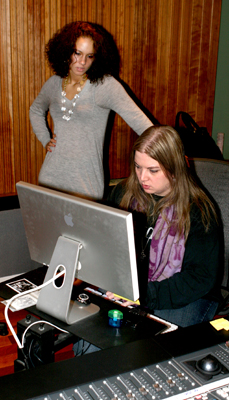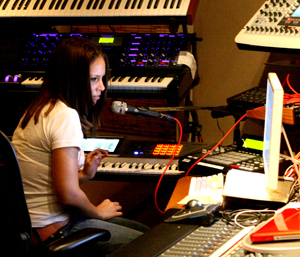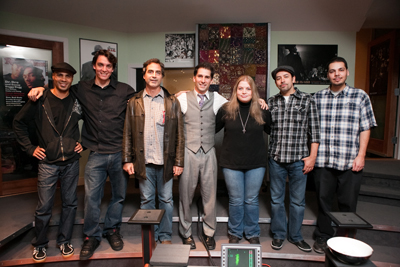Key To Keys: Ann Mincieli, Chief Engineer, Album Coordinator, Studio Managing Director
 Ann Mincieli is Alicia Keys’ recording engineer, album coordinator, studio designer and sonic adventure guide. She is the master facilitator — the Oven is Keys’ studio and Mincieli is its pilot light.
Ann Mincieli is Alicia Keys’ recording engineer, album coordinator, studio designer and sonic adventure guide. She is the master facilitator — the Oven is Keys’ studio and Mincieli is its pilot light.
In her 10 years engineering records with Keys, Mincieli has spanned the sonic universe with the artist. When they jump in, they jump in deep, and The Element of Freedom finds them again in uncharted waters.
Inspiration comes from dipping around in many different sonic inkwells, testing them out on canvas — streaks of new colors, swatches of new textures. Together, Keys and Mincieli build up a unique sonic palette and the production envelops the recording process; they’re not just recording instruments, they’re painting with sound.
Here, Mincieli fills us in on the sonic origins of The Element of Freedom, and describes her creative engineering role in the studio with Keys.
What was Alicia’s vision for how she wanted this record to sound?
Every record is completely different and really does start out with a vision We’re always experimenting with new and different sounds in between records and in pre-production. We’d collected 20+ old drum machines from the 70s and 80s, and in the very beginning this record really wasn’t going to be so geared towards 80s sounds, but that’s where she ended up once we started experimenting with all these drum machines.
Since building The Oven (’03), we’ve been collecting synths and vintage instruments, amps and gear of all kinds. I’ve been on eBay buying new synths — Moogs and Prophets — we’ve filled a whole keyboard room. For this album, knowing we were gearing more towards the 80s sounds, we picked up a CP70, an Oberheim, Roland Juno-6 and Juno-106. Where the last record, As I Am, was a lot of Clavi, Rhodes, Wurli, this album is more Juno, Jupiter, CP70 and Moog.
I’m also a huge collector of guitars and basses, amplifiers and pedals because that’s part of how I engineer. If you listen to As I Am, you can hear a lot of amps and pedals are used on her keyboards. We don’t ever use a sound that’s right out-of-the-box, it’s always tweaked, put through a pedal, a guitar, an amp. And it’s the same with these synths, we don’t grab the Motif or Phantom and use a stock sound. That’s too easy.
What do you think Alicia got out of expanding her palette with so many new and different synths? Was that inspiring for her as a songwriter?
Yes! It allowed her to paint a picture. We have class before every album. On this album, we decided that instead of trying to learn the synths while we’re on sessions, like we did on As I Am, we spent two months with the manuals, figuring out how everything worked — and by doing that, it unlocked all these sounds, and inspired her to write certain things she would have never come up with.
When you’re working on a session and you have a producer sitting next to you and you’re on the clock, you’re thinking, ‘I have to get this song done.’ You can’t take the time to really get in deep with the synths. So, this time around, we spent a lot of time sitting at each synth and say let’s go thru the patches and the banks: write down what we like; learn what the oscillators do, learn what the VCOs and filters do. Then you start matching tones.
The way Alicia starts off a song, it’s like she has this vision, and she’s trying to painting a picture of it. We don’t just record. We create and use all these different colors. And by having all these tools, she can really recreate any tone and sound she wants, between the guitars, amps, pedals, keyboards, microphones that we have. We just bought a Carol Kaye Versatone Bass amp that was her backup bass amp from the 60s. It sounds incredible. We’re really into getting and molding tones.
So, Alicia has a vision and a tone already in her mind when she’s writing a song: how she wants to hear it and what’s the theme of the song. And we experiment, with the guitars, amps and pedals, until we find what we like.
So, how long have you been working on the songs for this record?
Well, I’d say March, but it’s even earlier than that, because we started while we were out on tour. We’ll hit a studio wherever we are on days off. Alicia’s always working.
She’s always coming into the studio and experimenting. That’s the beauty of owning your own studio! You can wake up in the middle of the night, come in with your inspiration, your idea and work on it immediately. And for artists like her, she needs a studio like this. Because Alicia’s also a musician and a producer and she’s more technical and more into gear than any one of us. She programs drums better than most of the people on this album. But she just doesn’t want to waste time with it because she wants to write and sing and play piano, etc…
 What would you say a couple of the discoveries, keyboard-wise on this record that really made an impact on the sound of the record?
What would you say a couple of the discoveries, keyboard-wise on this record that really made an impact on the sound of the record?
Definitely using Moog Voyager was really cool. Oh, and in creating the new Alicia Keys piano plug-in [due out Spring of ‘10], we came up with this effect. We made this sound that sounds like a chorus guitar, but in reality, it’s her piano going through a bunch of filters and choruses and you can’t even tell it’s not guitar.
So, you’re looking to create unique textures?
Yes. She’s like a Prince or a Stevie Wonder, where she really experiments in the sound. Not a lot of artists do that anymore and it shows. Technology ends up hindering us, like if you take an artist like Britney Spears, who puts a song together like a puzzle. Literally. Everything is looping and robotic. It takes the human feel out of making music.
Alicia’s the opposite: she wants the session musicians to play from top to bottom because the good ones have a timing and a swing that makes everything feel real. You’re still in the pocket, but you’re not RIGHT on bar one, beat one. And it’s sad that a lot of the new up-and-coming engineers don’t even know the difference, the new musicians can’t play from top to bottom. They expect you to copy and paste.
Why would we want to copy and paste three choruses, when you could have a musician play it slightly different each time? So, in that way, technology’s really hindered us. Alicia’s coming from the 60s and 70s in her approach to making music. It’s very real. And she uses musicians to help her paint the picture.
How have you evolved as an engineer and producer through working on this record?
She’s the genius and we all add to what she does. I’m here making all of her sounds with her. I’m the engineer, but I’m not just pressing record. I’m tweaking filters and suggesting what to use and what to try. What guitars to pull out — I have 40 guitars of my own that are vintage. She has 15. And, they’re all here in the studio. When you have the exact guitars to recreate certain concepts that were used in the 60s and 70s, you can tell the difference vs. using a plug-in. You’re recording it right, on the front end of things, which is important.
We did a vocal effect on the song “Love Is Blind,” that’s a combination of a chorus and a Phaser, with the emotion of the vocal. If you shut the effect off, the whole vibe and tone of the song changes. The song is about being on the edge, no turning back. So that’s the kind of vocal tone we got.
And, every song has a different theme, a different vibe, a different mic. So, I’m happy to get to be influential that way. As an engineer, I’m painting a picture along with her. I’m forgetting all the technical, geeky things that we need to know and just turning knobs.
So, you get to play a very creative role in engineering her records.
Yes, I’m her engineer, her album coordinator and I work with her to make a lot of her unique sounds. We have two Pro Tools rigs we run together — we’re very big into virtual synths, as well as having all these hardware synths.
We have drums libraries like you could not believe! I’ve sampled, through tape and straight out of these drums machines through old mic pre’s, all these old drum machine sounds and then I load them into Battery and I make banks. Alicia uses an MPC as a sequencer to trigger all these drum samples from Battery and I’ll have four banks in her MPC and in Battery you can add rows and banks and have the pads learn where the samples are assigned in Battery and you have four banks of drum machines.
We sit there all day just making the coolest tones and it’s very organized — we have all these drum libraries that we’ve collected, bought off eBay, got from other people, sampled from her own albums. And then I’ll find a guy on eBay selling 50 drum machine samples — he’s sampled every drum machine from Ace Tones to Casios, etc…and then we take those and grimy them up, put them through amps and make libraries of our own.
So, it’s pretty intense. This is what we do in our off-album when we try to be productive. It’s really cool. And as an engineer, I like to inspire. Every session I have, I’ll bring in a new keyboard, to keep the inspiration high. Inspire greatness.
Is there as much live instrumentation on this records as on her others?
Yes, absolutely. Alicia likes to play a lot of guitar and combine live bass and Moog bass. We used the infamous Carlos Alomar on guitar for the majority of this album. We use a drummer named Steve Wolf on a number of songs. And, we also have live strings on 4 or 5 songs. We used a string guy, Davide Rossi, who works with Coldplay. He’s plays four instruments and does all the string parts himself.

The whole team! (l-r): Val Brathwaite, Stuart White, Tony Maserati, Dave Kutch, Ann Mincieli, Manny Marroquin and Erik Madrid.
How about this workflow? Why does it work so well having everyone here under one roof, from you and Alicia and Kerry, to Manny and Tony and Dave Kutch. The whole chain?
Well, I spearheaded the whole workflow. I coordinate everything — choosing the session musicians, the studios we use. I look at it as a total team effort. I have a way of finding what people are good at and using it! With Dave Kutch [mastering engineer], we brought him in on the last project As I Am. And turned the studio into a factory.
And that’s Alicia’s vision. She wanted Motown! Nowadays, there’s no studio communities. I wanted this place to be like the old-school. My drives are organized in a huge safe in the basement. Every decision here is really carefully considered.
We got down to crunch time, and it was our idea to bring in another mixer, Tony Maserati and put him at the studio up the road, to get the mix flow happening quicker because, as the artist, Alicia felt the pressure of having to mix 28 songs in a very short amount of time. The pressure was taken off by mixing in two rooms at once. We didn’t have the same amount of time like we did on As I Am and we had to mix more bonus material.
Did you learn anything from the in-house workflow used to produce the last record that you were able to incorporate into the making of this new record? Where there any tweaks you made to the process?
It really spared us more time. We were mastering at the same time as we were mixing at the same time as we were tracking. We were able to listen to the mastered tracks on our own speakers and we mastered the album over two months.
On the last record, we didn’t have a Duality downstairs. We re-did Studio A and put a Duality in, and flipped up the vibe. Little things like changing the posters and lamps, and candles and carpets — that’s important. We change up the theme and vibe of the studio on every album.
Sounds like she’s an inspiration to work with, that she pushes everyone on her team to be their absolute best.
She’s genius. We’re only here adding to what she does. She really raises the bar in the industry….in this day and age of American Idol and technology, how many artists do this anymore?
And I think we’ve learned a lot from each other over the years. I take engineering way to the creative side and it’s really cool to work for an artist that means so much to the world of music and is pure genius in terms of songwriting and singing and playing and producing.







Rob Zantay
December 16, 2009 at 4:42 pm (15 years ago)I was working in the NYC studios in the 1980’s as a first call synth programmer, Lyricon/YamahaWX-7 player. It is great to hear that Alicia Keys is bringing back the kind of music making that I have always been a part of. I have my own Sonar DAW studio in my NYC apartment where I create tunes for me to play my wind controller, flute and saxophone improvisations over. I would love to get a chance to work with Alicia, she really understands that it is the feeling that the players bring to the music that makes it unique and memorable. If everything is robotic and quantized the listener’s brain sort of turns off because there is nothing unexpected in the sound, but when real musicians are playing the listener is engaged because there are suprises in the music and you have to listen to find out what is going to happen next.
Heart
December 18, 2009 at 7:11 am (15 years ago)“Ann Mincieli is Alicia Keys’ recording engineer, album coordinator, studio designer and sonic adventure guide. She is the master facilitator — the Oven is Keys’ studio and Mincieli is its pilot light.”–Too Right!
“Anntastic the Fantastic!” Loving the photo of the “Whole Team” let’s call them… “The magnificent 7” lol. I love articles like this!
Here we are given the “meat and potato’s” of the music, how it came to life.
Here’s another great quote.. “Together, Keys and Mincieli build up a unique sonic palette… they’re not just recording instruments, they’re painting with sound.”–Awesome word picture! A perfect description!
Ann IS the “Picasso” of engineering and Alicia.. Well let’s just say even “Michelangelo” would be impressed! The Q&A in this article was on point!
Very informative! The kind of info a connoisseur of sound appreciates.
xxoo 😉
V.
Heart
December 18, 2009 at 12:11 am (15 years ago)“Ann Mincieli is Alicia Keys’ recording engineer, album coordinator, studio designer and sonic adventure guide. She is the master facilitator — the Oven is Keys’ studio and Mincieli is its pilot light.”–Too Right!
“Anntastic the Fantastic!” Loving the photo of the “Whole Team” let’s call them… “The magnificent 7” lol. I love articles like this!
Here we are given the “meat and potato’s” of the music, how it came to life.
Here’s another great quote.. “Together, Keys and Mincieli build up a unique sonic palette… they’re not just recording instruments, they’re painting with sound.”–Awesome word picture! A perfect description!
Ann IS the “Picasso” of engineering and Alicia.. Well let’s just say even “Michelangelo” would be impressed! The Q&A in this article was on point!
Very informative! The kind of info a connoisseur of sound appreciates.
xxoo 😉
V.
Sarahkende
January 4, 2011 at 9:59 am (14 years ago)hello my name is Sarahsuz.
I live in Oxford, I’m originally from Africa from Congo Brazzaville.
I will be 17 years old on the 6th of February.
I want to become a singer, I sing for my church choir, weddings and events.
I dream of becoming a singer and believe that I can make it, please I need help from you.
I will do everything ,I’m working hard singing and also I’ve wrote few songs which I need help with . please I just need help from a someone who knows more about recording music etc… please I will not let you down.
Thank you ,God bless
sarahkende@yahoo.fr
yc
June 6, 2013 at 9:27 am (11 years ago)dude keep working hard and your moment to show what you love will come… the key here is preparing for that moment….